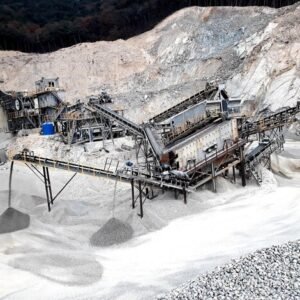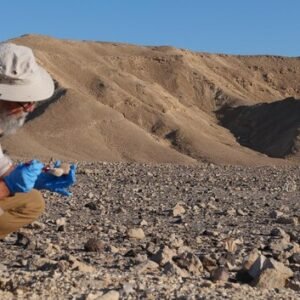Geosynthetic clay liners are hydraulic barriers that are manufactured in a factory. They consist of two geotextiles/geomembranes held together by needling, stitching, or chemical adhesives, with sodium bentonite clay or other shallow permeability material between them.
Development Of GCL:
Any solid waste generated from industrial, mining, agricultural operations, community activities, and urban construction contains various contaminants that pose serious environmental and public health hazards.
To minimize the hazards of this waste, it needs disposal in either a physical or a biogeochemical manner. Landfills were often the eventual fate of most solid waste regardless of the adopted treatment method. The process of landfills has developed throughout the years. We can divide them into three stages:
- Before the 1940s, waste was dumped directly into landfills.
- From the 1940s to 1970s, sanitary landfills in which dirt was used as a cover for the waste.
- After the 1970s, closed landfills had barrier liner systems to mitigate contamination of the surrounding environment.
- In the early 1980s, landfills used a compacted clay liner (CCL) barrier system.
- In 1982, Mr. Arthur J. Chem filed a patent for GCL, which combined a geotextile, adhesive, and bentonite clay.
- By the end of the 1980s, compacted clay liner was substituted by geomembrane (GM).
- Since the start of the 1990s, geosynthetic clay liners (GCL) have been used as a barrier system in landfills.
For the past 30 years, extensive studies have been conducted on the physical and mechanical properties of GCL and bentonite-based barriers. The following aspects have studied the properties of GCLs:
- Self-healing Capacity
- Hydraulic Conductivity
- Diffusion
- Chemical Compatibility
- Migration of Gas
- Mechanical Behaviors
The above-stated properties are related closely to bentonite’s mineralogy and form. They have been studied extensively in the past decade due to an increase in the application of GCL materials in mining and industrial processes. This was done to investigate the effect of exposure to extreme conditions and environments like extreme cold, extreme heat, strong alkalinity, strong acidity, hypersalinity, etc on GCLs properties.
Also Read: – Bentonite cat litter market
Applications Of GCL:
GCLs play a critical role in several environmental containment applications. They also offer effective fluid containment solutions. The following are a few of them:
- Landfill Lining:
Landfills are built especially to contain and manage waste efficiently. They must be handled properly, or they can be one of the greatest environmental threats. One of the most common uses of GCL is being part of the liner system in landfills. They act as a barrier to help prevent solid waste and leachate (a liquid that forms as waste decomposes) from seeping into the surrounding groundwater and soil.
- Mining Applications:
GCLs are used in mining applications mainly for containment and reinforcement. They are used to line containment regions and tailing and evaporation ponds. They are also used in heap leach facilities, impoundments, stormwater containment, and closures. They prevent water seepage and protect the release of potentially hazardous materials into their surroundings.
- Wastewater Treatments:
They line ponds, lagoons, and containment basins in wastewater treatment facilities. They help prevent wastewater leakage and treat effluents into the soil, ensuring that contaminants are managed properly.
- Soil Erosion Control:
GCLs can stabilize slopes and channels in areas prone to erosion, thus preventing soil erosion. GCLs are often installed with vegetation to create an effective soil erosion control system.
- Construction:
GCLs are used to construct roads, railways, and residential and commercial areas. Building roads can help mitigate the deformation of roads and prevent the breakdown of their structural integrity. They are also utilized in the waterproofing of the foundation to prevent moisture damage to the structures.
- Land Reclamation:
GCLs are often used in reclamation projections to remediate former landfills and contaminated sites. GCLs allow for restoration of the contaminated land and make it useful again for residential, agricultural, or recreational purposes.
Overall, GCLs serve many uses and provide cost-effective and reliable solutions to mitigate environmental contamination. They help to protect the environment and public health and ensure the sustainability of the development of any infrastructure. At the core of GCLs lies bentonite, a naturally occurring clay known for its low hydraulic conductivity and high swelling capacity.
Also Read: – Bentonite manufacturers in india
What Are Geosynthetic And Bentonite Clay Liner Uses?
GCL consists of bentonite with high mechanical behavior and easy and fast installation. GCLs serve as barriers against the migration of fluids and seepage of contaminants in several engineering projects such as landfills, mining sites, etc.
Let’s dive into the purpose of GCL-grade bentonite:
- Permanently Waterproof:
Sodium Bentonite is an inorganic material found in nature. Due to this, it doesn’t age or corrode, even after a long time passes or under any environmental change, making it permanently waterproof.
- Easy Construction:
GCLs are easier to construct than other waterproof materials. They are supplied in rolls and panels. Since GCL panels are prefabricated, they reduce the time needed to build them. The flexibility of GCL panels makes them easy to construct on uneven or difficult areas.
- Self Repair:
Bentonite has a self-healing quality due to its high swelling properties in case of local damage, punctures, or minor penetrations caused by field installation. This helps maintain the liner’s integrity for a long time, thereby reducing the chances of leakage and the need for maintenance.
- Compatible With Geotextiles:
GCL-grade bentonite is tested rigorously to ensure it is compatible with the different environments and extreme conditions. GCL-grade bentonite combined with high-quality geotextiles provides long-term stability and enhanced durability.
- Environmental Protection:
Bentonite is proven to be non-toxic and harmless to humans. It is environment-friendly, too.
In short, GCL-grade bentonite plays a crucial role in engineering applications and the functionality of GCLs. It provides unique properties like low hydraulic conduction, self-healing capabilities, and cost-effectiveness, making it a key component of GCLs.
Also Read: – Bentonite pond sealer
Why CMS Bentonite?
CMS Industries is one of India’s highest quality GCL grade bentonite manufacturers, suppliers, and exporters. CMS Bentonite has more than 70% montmorillonite, is considered better, and is popularly used in constructing GCLs.







